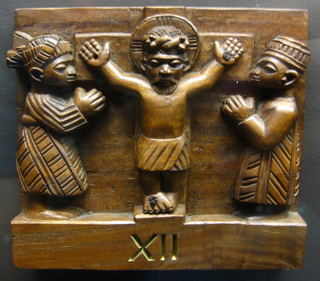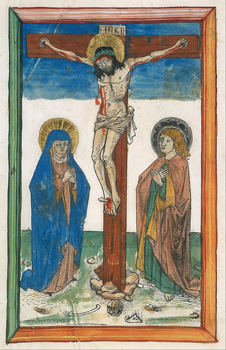For Sunday March 18, 2018
Fifth Sunday in Lent
Lectionary Readings (Revised Common Lectionary, Year B)
Jeremiah 31:31-34
Psalm 51: 1-12
Hebrews 5:5-10
John 12:20-33
Two lines from this week’s Gospel reading stand out to me: “Sir, we wish to see Jesus,” and “When I am lifted up from the earth, I will draw all people to myself.” One is a request; the other is a mystery, and there’s a relationship between the two that I want to understand better. Somehow, the mystery answers the request. But how? What happens when Jesus is “lifted up” from the earth? What do we see when we look at the cross? What kinds of drawing, gathering, and communing become possible in its shadow?
We begin with desire: “Sir, we wish to see Jesus.” The setting is Jerusalem, the occasion is Passover, and the people making the request are Gentiles, visiting the city for its traditional religious festivities. The Gospel doesn’t tell us how many Gentiles come asking, or why they’re interested in Jesus. Are they curious about his message and his parables? Are they chasing spectacle — hoping to see Jesus walk on water or heal a blind man? Maybe they’re skeptics or troublemakers, looking to pick a fight with the controversial Nazarene. Or maybe they’re just bored and seeking a distraction. There’s no way to know — all we can do is guess.
 |
But I’m grateful for that, because when I look at my own life, I can recognize the Gentiles’ request in all of those guises. I know what it’s like to want Jesus in earnest — to want his presence, his guidance, his example, and his companionship. I also know what it’s like to want not him, but things from him: safety, health, immunity, ease. And finally, I know what it’s like not to want him at all — what it feels like to shelve all spiritual desire, and allow my faith to fade into the background of my life and consciousness. I cycle endlessly between these three. My heart for Jesus expands and constricts; my desire to see him waxes and wanes, and my motives for seeking him grow purer and coarser by turns.
“Sir, we wish to see Jesus.” On its face, it’s such a simple request, but it cuts to the heart of so many kinds of spiritual growth, stagnation, and defeat. Do we want to see Jesus? Do we now? During this season of Lent, are we asking to see the Jesus we’ve heard so much about? If yes, which Jesus do we wish to see? The teacher? The healer? The peacemaker? The troublemaker? Why are we interested? Or, if we’re not asking and seeking, then the question shifts, and we have to ask it differently: why is Jesus not on our radars? Does “seeing” him feel impossible right now? Uninteresting? Irrelevant? Has he become so familiar to us that he’s faded away entirely?
The second line I’ve thought about this week is the more cryptic one. Following the Gentiles’ request, Jesus launches into a meditation on his death. He says his hour has come. He describes himself as a grain of wheat falling into the ground and dying in order to bear much fruit. He invites his followers to “hate” their lives in this world and keep them instead for eternal life. He admits that he’s afraid: “Now my soul is troubled.” And finally, he describes the cross as a gathering place of agony, glory, unity, and communion: “When I am lifted up from the earth, I will draw all people to myself.”
 |
In a few weeks, many of us will gather in our respective houses of worship for Good Friday services. We’ll remember and we’ll keep vigil. We’ll meditate, pray, sing, and weep. We’ll kneel, or walk the Stations of the Cross, or listen to homilies, or chant the liturgy — all in the hopes of entering into the deep mystery of the Cross. All in the hopes of honoring what Jesus made possible when he was lifted up from the earth.
But for those of us who've grown up in the church, the actual scandal and strangeness of Jesus’s death has perhaps long faded away. We’re used to worshipping in front of a crucifix; we genuflect without thinking, or wear tiny crosses around our necks. But what would happen, I wonder, if we could shake ourselves out of our familiarity for a few minutes, and see with new eyes what happened on Good Friday? God died. Jesus willingly took the violence, the contempt, and the hatred of this world and absorbed them all into his own body. He chose to be the victim, the scapegoat, the sacrifice. He refused to waver in his message of universal love, grace, and liberation, knowing full well that the message would cost him his life. He declared solidarity for all time with those who are abandoned, colonized, oppressed, accused, imprisoned, beaten, mocked, and murdered. He burst open like a seed so that new life would grow and replenish the earth. He took an instrument of torture and turned into a vehicle of hospitality and communion for all people, everywhere. He loved and he loved and he loved, all the way to the end. “When I am lifted up, I will draw all people to myself.”
If we, like the Gentiles, want to see Jesus, the place to look is to the cross. Yes, Jesus was and is many things: teacher, healer, companion, and Lord, and it is essential that we experience him in all of these ways. But the center, the heart of who he is, is revealed at the cross. The cross makes true sight possible.
 |
In the end, what this week’s Gospel reading teaches me is that I don’t have to strive and strain to see Jesus. As he told those Gentile seekers two thousand years ago, he is the one who draws and gathers all people to himself. He is the one who allows himself to be lifted up, so that what is murky or overwhelming or frightening — God in his indecipherable Otherness — comes close and becomes visible.
In other words, Jesus desires steadily when I desire unsteadily. He loves whether I love or not. It has taken me a long time to believe this and to trust it, but now I do: Jesus’s longing for me is the ground upon which all of my desire — however abundant or stingy — rests. He wishes to see me — to see all of us — far more urgently than we’ll ever wish to see him. And this isn’t a rebuke. It isn’t an invitation to self-loathing or shame. Rather, it is a promise and a refuge. We love because he loves first. We love because the cross draws us towards love — its power is as compelling as it is mysterious. The cross pulls us towards God and towards each other, a vast and complicated gathering place. Whether or not I want to see Jesus, here he is, drawing me. This is the solid ground we stand on. Stark, holy, strange, and beautiful.
Image credits: (1) The Jesus Question; (2) Blogspot.com; and (3) Wikipedia.org.





